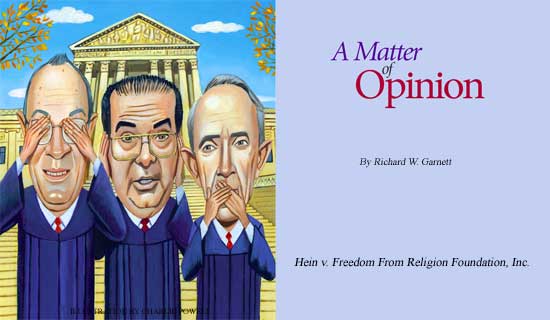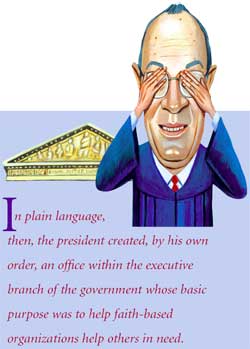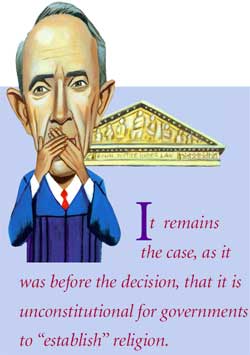A Matter of Opinion
Richard W. Garnett November/December 2007
As we all learned—or should have learned—in school, the Constitution of the United States created a new, national government of limited, divided powers. Of course, the Constitution was and is not perfect. Still, it is worth remembering and celebrating the Founders' insight and creativity. Theirs was a bold, innovative experiment. Those who designed and ratified the Constitution firmly believed that the best way to safeguard the liberties of individuals and local communities was to pay close attention to the structure and design of the federal government and, in particular, to separate that government's power among three coequal branches.
Now, it might be tempting to think that basic civics-course observations like these are fine for history classes, and well and good for museum exhibits, but not particularly relevant to our contemporary debates. However, as the Supreme Court's recent decision in a closely watched case called Hein v. Freedom From Religion Foundation, Inc. illustrated, questions about the distinct roles and limited powers of the several branches of government remain on the front burner.
In January 2001, President Bush issued an "executive order" creating the White House Office of Faith-Based and Community Initiatives. The mission of this new office included making sure that "private and charitable community groups, including religious ones. . . have the fullest opportunity permitted by law to compete on a level playing field[.]" A specific goal for the office was to reduce and cut through the bureaucratic red tape and unnecessary regulatory barriers that, the Bush administration believed, unfairly limited the ability of these groups to access federal program funds. Although these groups were not to use public money for—quoting from another executive order— "inherently religious activities, such as worship, religious instruction, or proselytization", and were not to "discriminat[e] against beneficiaries or potential beneficiaries. . . on the basis of religion[,]" the president insisted that no charitable organization "should be discriminated against on the basis of religion. . . in the administration or distribution of federal financial assistance under social service programs." In plain language, then, the president created, by his own order, an office within the executive branch of the government whose basic purpose was to help faith-based organizations help others in need. What's more, the new office and its activities were funded not by any law enacted by Congress specifically for that purpose, but out of "general Executive Branch appropriations."

Now, questions involving the use of public funds by or in religious institutions and schools are difficult ones, and have been the subject of dozens of famous Supreme Court decisions during the past 60 years. To make a long story short, the Court's current position appears to be that it is not necessarily an unconstitutional "establishment" of religion for government to fund, as part of an evenhanded public program, the nonreligious activities of a religious organization. And so, for example, the Court ruled a few years ago, in the case of Zelman v. Simmons-Harris, that it was not unconstitutional for Ohio to allow low-income students in Cleveland to use publicly funded scholarships to attend religiously affiliated schools. Whether the Faith-Based Initiatives Office's conferences and other activities crossed the hazy line that separates permissible evenhandedness toward religion from illegal endorsement is a question about which expert lawyers and scholars disagree.
Even after Hein, they still do. This is because, by the time the case reached the Supreme Court, Hein was not really about the constitutionality of the Office's conferences at all. The case did not address, and so did not resolve, the question whether the foundation's constitutional complaints were justified; instead, the justices considered whether or not the foundation and its members had "standing" to bring that complaint in federal court. The trial court concluded that they did not, but the court of appeals decided otherwise. And, this disagreement led to the first church-state decision of the newly constituted Roberts Court.
What, exactly, is the doctrine of "standing"? Some commentators and journalists, in their discussions of Hein, seemed frustrated with the concept, regarding it as a distracting and typically arcane or achaic lawyer's technicality. In fact, though, it is a rule that is closely connected to bedrock separation-of-powers principles and foundational features of the Constitution's design.
The Constitution does not give the federal courts the power to answer constitutional and other legal questions—even important ones—in the abstract. Under our Constitution (some other nations' constitutions are different), the courts' function is not to offer constitutional advice, or to unravel law-school hypotheticals, or to review for constitutionality all the various activities of the other branches of government. As Justice Alito put it in Hein, our courts are "courts of law", not "general complaint bureaus." It is not enough that someone has an objection to a particular policy, or even a good argument that the policy violates the Constitution. Instead, the federal judiciary's "judicial power" extends to "cases" and "controversies" involving real parties with an actual stake in the dispute—in other words, with "standing."
And so, when the foundation and its members sued the administration in federal court, they argued that they had "standing" because they pay federal taxes and oppose the use of tax dollars to advance, promote, and endorse religion. In most cases, this is not enough. That is, the mere fact that a person pays taxes is usually not enough to permit a person to object to government programs and policies in federal court. If it were enough, the theory goes, then taxpayer lawsuits would undermine the constitutional design, with its liberty-protecting separation of powers, by dramatically expanding the judiciary's reach at the expense of the two politically accountable branches of government. To have "standing," a plaintiff must allege an "injury" that is traceable to the defendant's conduct. Feeling that the government is misusing one's tax dollars—a widespread feeling, to be sure—is not a sufficiently concrete "injury" to warrant the federal courts' involvement.
Almost 40 years ago, however, in a case called Flast v. Cohen, the Supreme Court created a narrow exception to the no-taxpayer-standing rule in establishment clause cases. In Flast, the taxpayer-plaintiffs challenged the distribution of federal funds to religious schools under the Elementary and Secondary Education Act of 1965, insisting that this assistance violated the First Amendment. The justices decided that, in cases like this, objections to Congress's exercise of its power under the Constitution to tax and spend were enough to establish the required standing. This exception was appropriate, they reasoned, because—as James Madison's famous "Memorial and Remonstrance" illustrates—the framers had been particularly and specifically worried that the tax-and-spend power would be used to support religion, or to favor one religion over another.
In Hein, though, the challenged activities of the Faith-Based Initiatives Office had not been funded by Congress, but instead created and funded by the executive branch. Accordingly, the trial court dismissed the case. The court of appeals, though, stated that, under Flast, taxpayers could challenge a program or policy of the executive branch so long as it was "financed by congressional appropriation." In that court's view, the justification offered in Flast for taxpayer standing to challenge acts of Congress applied with equal force in cases like Hein. On the other hand, Judge Ripple warned in his dissenting opinion that the decision was a "dramatic expansion" of the Flast exception, one that increased the power of the courts and threatened the separation of powers.

Justices Scalia and Thomas agreed that the foundation and its members lacked standing, but wrote separately to criticize the "utterly meaningless distinctions" on which their colleagues in the majority relied. If Flast is good law, they explained, then it should apply to cases like Hein. However, they insisted, Flast was quite wrong, and impossible to reconcile with the Constitution's text and structure. It should therefore be rejected, and not artificially narrowed or distinguished.
Justice Souter dissented, writing for himself and three other justices. He focused on the injury that, in his view, is done to a taxpayer's conscience when the government spends public funds in a way that violates the establishment clause. As James Madison wrote, "[t]he Religion. . . of every man must be left to the conviction and conscience of every man." Coerced support of religion through taxation, the dissenting justices believed, insults this conviction and burdens this conscience, and inflicts an "injury" that is sufficient for "standing" purposes.
Reactions to Hein have been mixed. Some, like Justice Scalia, chided Justice Alito for being too timid about rejecting Flast and its unjustifiable expansion of the judicial power. Other critics agreed with Justice Scalia that the distinction between executive spending and congressional appropriations was vague and illogical—the New York Times called it "cockeyed" and "flimsy"—and worried that the ruling would limit Americans' ability to vindicate the First Amendment's commands and open the door to a range of unconstitutional presidential support of religion. President Bush, on the other hand, hailed the decision as a "substantial victory for efforts by Americans to more effectively aid our neighbors in need of help."
Those Americans who are committed to religious freedom under law, and who believe that a distinction between religious institutions and those of government is a crucial safeguard for that freedom, should not regard Hein with alarm. It remains the case, as it was before the decision, that it is unconstitutional for governments to "establish" religion. If anything, Hein would seem to reinforce the insight that is at the heart of the church-state separation, namely, that freedom is best preserved when powers are distinguished and divided.
Richard W. Garnett is associate professor of law at the University of Notre Dame, South Bend, Indiana. He has often lectured and written on church-state issues. In 1996-1997 he clerked for Chief Justice Rehnquist.
Article Author: Richard W. Garnett
Richard W. Garnett is an Associate Dean and Professor of Law at the University of Notre Dame School of Law. Professor Garnett teaches and writes about the freedoms of speech, association, and religion, and also about constitutional law more generally. He is a leading authority on questions and debates regarding the role of religious believers and beliefs in politics and society. He has published widely on these matters, and is the author of dozens of law-review articles and book chapters. His current research project, Two There Are: Understanding the Separation of Church and State, will be published by Cambridge University Press. He is the founding director of Notre Dame Law School’s new Program in Church, State, and Society, an interdisciplinary project that focuses on the role of religious institutions, communities, and authorities in the social order.